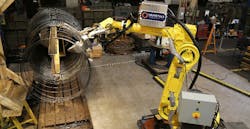A Robotics Challenge in the Metals Industry
In the metals industry where I have worked for most of my 32 years in engineering, long rolling plants that manufacture end products like wire and reinforcement bar are particularly labor intensive. They comprise multiple rolling and metallurgical processes, many of which need frequent human interaction.
Some processes require operators to approach the production line as the steel is being rolled. Others require manually manipulating equipment to ensure product quality. Many of these tasks come with a risk of injury if not carried out correctly. They may also require close interaction with other individuals, shared tooling and confined working spaces. Precautions taken to effectively carry out these tasks while minimizing the risk of spreading COVID-19 can slow down the work and reduce production output.
A good example is the designated coil trimming area in a rolling line. Here, two to four operators work in close proximity with shared tools to precisely trim the head- and tail-ends off a long, thin piece of metal formed in a spiral coil. Plants with the highest production can process a coil every 45 seconds. The coils may be as hot as 1,200 degrees Fahrenheit and the processing space may be limited. In such a high-pressure environment, product quality and safety cannot always be maintained.
As a result, operators have sustained everything from burns and lacerations to sprains, strain and fatigue. In my role as head of technology for a metals industry engineering/solutions provider, I have heard about such experiences from our customers at least once every two months. My team at Primetals Technologies realized that automation could help reduce, if not eliminate, many of these experiences.
At first, we set out to build our own custom machine, but that approach proved far too complicated. We noted that robots have been automating very high-precision tasks in other industries for years (like welding in auto manufacturing plants). In the metals industry, other steelmaking processes have benefitted from such systems. For more than a decade, the company I work for has programmed and supplied robots to perform tasks that are dangerously close to hot liquid steel. For coil trimming, we believed that a vision-enabled robot would provide the repeatable accuracy that the task requires. So, we partnered with an established robotics company to acquire the hardware.
To ensure that a robot could duplicate and improve coil trimming, we conducted in-depth operator interviews as well as time-and-motion studies over multiple shifts. We soon learned that the application would be quite complex for an industrial machine.
To perform this task, the system must understand how to manipulate the coil correctly, count the rings, identify which ring to cut, and remove the coils successfully and repeatably. Plus, the system must be able to do this with material ranging in thicknesses from 5.5mm to 28.0mm and of varying grades and strengths. This is a straightforward process for an experienced operator. However, duplicating the human thought process in a machine with no perceived intelligence or understanding of the physical world was the biggest challenge.
Machines are fast, accurate and repeatable within +/-0.1mm. However, they are not instantly intuitive or adaptable to situations they are not programed to work with. If the process you are trying to automate is variable, then you must consider all the variance cases or use machine learning to ensure repeatable variances can be accounted for.
For example, a human operator can quickly recognize if coil rings are tangled or overlapping and cut the next available ring. To overcome this challenge, we programmed the vision system to observe how the rings lay and at what angle. Through geometrical algorithms, the robot now recognizes such problems and moves past them to complete the task.
From our interviews with operators, we also learned that the job of “trimmer” is considered an entry-level job, and no one wants to build their career around that task. So, instead of cutting hot steel all day, operators can be trained to run and maintain the robot. As plants become more automated and operators take on more sophisticated challenges, we will see greater demand for job positions that can develop new systems. And these systems will need support and maintenance, creating new robotic engineering careers in all aspects of industry.
The metals industry can continue along this path by automating the mundane, repetitive and sometimes dangerous tasks. In the future, we can move toward the possibility of a fully remote or automated “dark” plant, with operators performing scheduled maintenance or troubleshooting certain domain specific know-how.
Matthew Palfreman is Head of Technology for the Long Rolling business segment of Primetals Technologies, a engineering, plant building, and lifecycle services provider for the metals industry. Primetals Technologies USA is a group company of Mitsubishi Heavy Industries, Americas.
